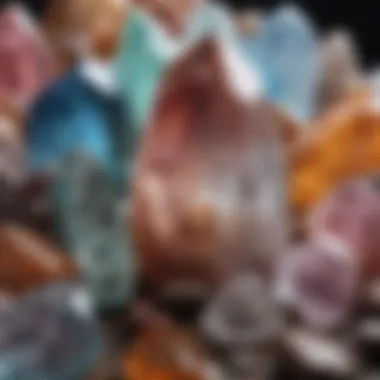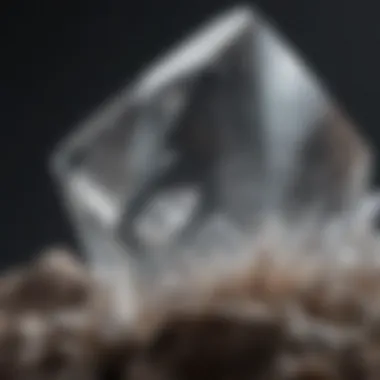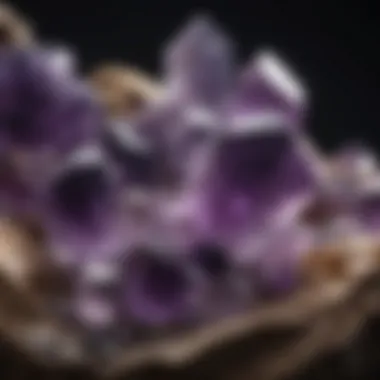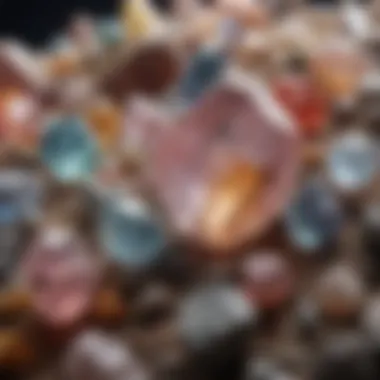Unraveling the Mysteries of Quartz Crystal Colours


Intro
Quartz crystals have fascinated humanity for centuries. Their wide range of colors captivates collectors, scientists, and enthusiasts alike. The hues vary immensely, influenced by numerous factors such as mineral inclusions, radiation exposure, and environmental conditions during formation. Understanding these colors requires a blend of geological knowledge and appreciation for their metaphysical attributes.
Identifying and valuing quartz crystals hinges on recognizing their distinctive colors. This exploration aims to enrich the knowledge base of rock and fossil collectors regarding quartz crystals. By delving into the origins of these colors, identifying them, and understanding their implications, collectors can appreciate these crystals at a deeper level.
History and Origins
Overview of Collectibles, Rocks, and Fossils
The journey of quartz crystals dates back millions of years. These minerals form through various geological processes, including volcanic activity, metamorphism, and sedimentation. Quartz is one of the most abundant minerals on Earth, making it a prevalent collectible in both geological and metaphysical circles.
Collectors value quartz not only for its aesthetic appeal but also for its historical context. Each crystal possesses a unique history, carrying information about the conditions under which it formed. This historical significance deepens their allure among collectors and geologists.
Historical Significance and Cultural Impact
Throughout history, different cultures have ascribed various meanings to quartz crystals. For instance, ancient Egyptians utilized clear quartz in burial rituals, believing it to channel spiritual energy. Indigenous tribes often viewed colored quartz, such as amethyst or citrine, as sacred, incorporating them into rituals and healing practices.
The color of quartz crystals also holds various cultural significances. For example, pink quartz is often associated with love and compassion, while smoky quartz is linked to grounding and protection.
"The color of crystals can convey deeper meanings that go beyond their physical appearance, resonating with the cultural narratives of different societies."
Identification and Classification
Guide to Identifying Rocks and Fossils
Identifying quartz colors involves a keen eye for detail and understanding mineral properties. Observing factors such as luster, transparency, and inclusions can help distinguish between quartz varieties. Distinct colors appear due to trace elements or impurities within the crystal structure. For example, iron impurities can turn quartz into a shade of yellow or brown, creating citrine or smoky quartz, respectively.
Common Types and Variations
Several types of colored quartz exist, and their identification is paramount for collectors:
- Amethyst: Purple hue, due to iron and natural radiation.
- Citrine: Yellow to brown, formed by heat treatment or iron impurities.
- Rose Quartz: Pinkish color, attributed to titanium or manganese.
- Smoky Quartz: Brown to black, formed due to natural radiation.
- Clear Quartz: Colorless, often used in jewelry and technology.
Each type holds unique properties that collectors often seek, driven by aesthetics and metaphysical claims. Recognizing these types aids collectors in valuation and appreciation of their specimens.
Understanding quartz crystal colors is an essential pursuit for enthusiasts, promising both intellectual engagement and connections to rich cultural heritages.
Preamble to Quartz Crystals
Quartz crystals are remarkable and widely appreciated within the realm of geology and mineralogy. This section sets the stage for understanding quartz crystals by emphasizing their significance, characteristics, and the various contexts in which they appear. The importance of quartz crystals goes beyond aesthetics; they represent a rich scientific background and hold various practical uses.
The study of quartz not only helps in recognizing their beauty but also in understanding the processes that lead to their formation. Moreover, for collectors, knowing about quartz colours and types enhances the value of their collections. This knowledge is crucial for identification and valuation, which are important aspects for many enthusiasts.
In this article, we will explore how colours play a pivotal role in quartz crystals. Each colour tells a unique story, revealing clues about the crystal's formation and the environmental conditions it endured. Through this exploration, readers will gain insights into how colours relate to the aesthetic and metaphysical properties of quartz.
Overall, gaining a comprehensive view of quartz crystals is essential for anyone interested in geology, collections, or the intrinsic beauty of minerals. This knowledge allows individuals to appreciate the striking diversity of quartz and navigate the complexities surrounding their identification and valuation in the mineral market.


The Science of Quartz Colours
Understanding the science behind quartz colours is crucial for anyone interested in these fascinating minerals. The colours of quartz crystals are not merely aesthetic; they reflect a complex interplay of geological and chemical processes. By diving into this aspect, collectors gain insights that enhance their appreciation of the specimens they obtain. Knowledge of the science behind colours also aids in identification, which is essential for valuing pieces correctly in a market inundated with imitations.
Formation of Quartz
Quartz formations begin in the Earth's crust, where molten silica cools and crystallizes over millions of years. This process can occur in various geological environments, such as igneous, metamorphic, and sedimentary settings. When the silica cools slowly, it forms large, well-defined crystals. Rapid cooling, on the other hand, can lead to smaller, less distinct forms. Temperature and pressure fluctuates during formation which also impacts the characteristics of the resulting quartz.
The crystallization of quartz has direct implications for its colour. For example, variations in temperature can lead to different structural patterns within the crystal lattice, which may cause distinct colourations. Additionally, the conditions in which the quartz forms, such as the presence of gases and minerals, also play a role in the eventual hue of the crystal.
Elements Influencing Colour Changes
The colour of quartz is often influenced by several elements. Iron, manganese, and titanium are among the key players in this process. For instance, traces of iron can result in smoke or yellow hues, while manganese significantly contributes to the pinks of rose quartz. These elements integrate into the quartz structure, altering its light absorption properties.
Further, the oxidation state of these elements can also impact the colours observed. For example, the oxidation state of iron can change under varying environmental conditions, leading to different shades of quartz. Thus, understanding these elements is essential for collectors who wish to recognize and categorize their crystals accurately.
The Role of Impurities
Impurities present in quartz can alter its appearance dramatically. These impurities can be other minerals, gases, or even organic matters that became trapped during the crystallization process. Inclusions may affect both the surface colour and the overall clarity of quartz crystals.
- Examples of Common Impurities
- Iron: Causes colours ranging from yellow to smoky.
- Manganese: Provides pinkish tones in rose quartz.
- Titanium: Can create shades of purple or blue.
The presence and concentration of these impurities usually determine a quartz crystal's value and desirability. Thus, recognizing how impurities contribute to colour variations can aid collectors in identifying high-quality specimens.
Understanding these fundamental concepts boosts one’s ability to assess and value their quartz crystal collection, making knowledge of science an essential tool for every collector.
Common Quartz Crystal Colours
Understanding the various colours of quartz crystals is crucial for rock and fossil collectors. Each colour not only represents a unique aesthetic but also signifies different mineral compositions and potential values. Knowing these colours can enhance a collector’s ability to identify, categorize, and appreciate their specimens. In this section, we will explore the main colours associated with quartz crystals, detailing their characteristics and significance.
Clear Quartz
Clear quartz is perhaps the most recognized type of quartz. Its transparency and lack of colour make it versatile for various uses. This crystal is composed purely of silicon dioxide. It is often regarded as a universal stone in both metaphysical practices and various industries. Clear quartz is seen as a powerful energy amplifier, making it popular among healers and energetic practitioners. It serves as a blank slate for setting intentions, enhancing the energies of other stones when combined.
Amethyst
Amethyst exhibits a stunning violet hue, resulting primarily from iron content and natural radiation. This colour can range from pale lavender to deep purple. Historically, amethyst has been valued for its beauty and metaphysical properties. It is said to promote calmness and clarity, which contributes to its popularity in jewelry and decoration. For collectors, the depth of colour often correlates with value; richer purples generally command higher prices.
Citrine
Citrine is unique due to its warm yellow to golden brown colours. This quartz variety is often mistaken for topaz. The yellow coloration comes from traces of iron within its structure. Citrine is associated with wealth and prosperity, making it a favored stone in both physical and metaphysical spaces. Because most commercial citrine is heat-treated amethyst, natural citrine is rare and highly coveted among collectors.
Rose Quartz
Characterized by its delicate pink hue, rose quartz is renowned for its soothing energy. It contains titanium, iron, or manganese that impart the distinctive pink shades. Collectors often seek out rose quartz for its emotional healing properties. It is related to love and compassion, making it a favorite among those interested in crystal healing. The appeal of rose quartz lies not only in its colour but also in its gentle energy that resonates with many.
Smoky Quartz


Smoky quartz can range from light grey to nearly black shades. Its colour arises from natural radiation or the presence of organic material during formation. It is often seen as a grounding stone, believed to absorb negative energy and promote mental clarity. The darker the stone, the more valuable it generally is. Smoky quartz is popular among collectors who appreciate its robust appearance and energetic properties.
Other Notable Colours
Beyond the well-known quartz types, there are other colours worth exploring. These include blue quartz, green quartz, and golden quartz. Each variant possesses unique characteristics and appeals to different collectors.
- Blue Quartz: Often associated with tranquility and healing.
- Green Quartz: Known for its growth-related properties.
- Golden Quartz: Reflects warmth and abundance.
By understanding these different colours of quartz, collectors can make informed decisions regarding their collections. The value, uses, and meanings of quartz are deeply tied to their unique hues, making this knowledge essential.
Metaphysical Implications of Quartz Colours
Metaphysical implications of quartz colours are essential to understanding the broader context of these natural formations. Quartz crystals, revered for their unique aesthetic attributes, often carry symbolic meanings that can influence personal and spiritual practices. Collectors and enthusiasts recognize that each colour tends to embody different energies or properties, shaping the experiences of those who work with or wear these crystals.
Cultural Significance
Throughout history, various cultures have assigned distinct meanings to quartz colours. For instance, clear quartz is often viewed as a universal healing stone, symbolizing clarity and purification. Many indigenous cultures regarded amethyst as a protective stone, believed to enhance intuition and fend off negative energies. Citrine has been associated with prosperity and abundance, often called the "merchant's stone" in some traditions. The rose quartz, with its gentle pink hue, signifies love and compassion, becoming a staple in healing rituals related to emotional well-being. Moreover, smoky quartz is often linked to grounding and protection, serving as a shield against negativity.
It is crucial to understand these cultural significances, as they provide insight into how quartz is perceived and used in various spiritual practices around the world. Many collectors actively seek these stones not just for their beauty, but also for the cultures and histories they represent.
Healing Properties Associated with Colours
The healing properties attributed to quartz colours further enhance their allure among collectors. Many believe that different colours resonate with specific chakras, thus impacting emotional and physical well-being. It is important to highlight some notable associations:
- Clear Quartz: Known for amplifying energy and intention, widely used for clarity in meditation.
- Amethyst: Thought to aid in stress relief and is often used during meditation for calming effects.
- Citrine: Believed to boost confidence and stimulate the intellectual mind, thereby fostering creativity.
- Rose Quartz: Associated with the heart chakra, promotes love, peace, and emotional healing.
- Smoky Quartz: Grounding stone that is said to mitigate negativity and enhance practical decision-making.
Such properties not only contribute to the crystals' value but also guide collectors in their selections. Understanding the metaphysical properties tied to these colours can significantly deepen one’s appreciation and interaction with quartz crystals.
"Crystals are more than mere decorations; they are catalysts for personal transformation and healing."
This exploration into the metaphysical implications serves as a critical guide, assisting collectors in making informed decisions that align with their intentions and spiritual journeys.
Identifying Quartz Crystals by Colour
Identifying quartz crystals by colour is a vital skill for collectors and enthusiasts alike. The specific hues present in quartz can indicate not only the type of crystal but also its origin and potential value. Each colour carries its unique set of characteristics and commercial implications.
Understanding the nuances of colour in quartz enhances the collector's knowledge and appreciation of these minerals. For example, a clear quartz might be worth less than an amethyst, which often commands higher prices due to its vivid purple shades. Knowing how to differentiate these colours accurately helps in making informed purchasing decisions.
There are several key benefits to being able to identify quartz crystals by their colours:
- Value determination: Different colours can significantly affect market prices.
- Collecting strategies: Identifying colours helps collectors focus on particular types that interest them.
- Interpretation of properties: Certain colours in quartz are associated with metaphysical attributes, guiding collectors in their choices.
Special considerations include understanding that colours can be influenced by several factors, ranging from natural irradiation to the presence of trace minerals. Therefore, accurate identification must consider these variables.
Guidelines for Identification
- Observe the Colour: Start by assessing the overall colour of the quartz crystal. Notice if it is uniform or exhibits banding.
- Check for Impurities: The presence of other minerals can impact the perceived colour. A quartz crystal with slight inclusions may show different hues.
- Explore Lighting Conditions: Different light sources can affect how a crystal’s colour is viewed. Examining the crystal in natural light can yield the most accurate assessment.
- Utilize Comparison: Collectors should compare their specimens with known examples. This can help refine the understanding of quartz colours and identify subtle differences.
Tools for Collectors


To assist in the identification of quartz crystal colours, collectors should consider utilizing various tools:
- Loupe or Magnifying Glass: This allows for close examination of surface details and impurities, crucial for accurate identification.
- Light Source: A portable light can help test how a crystal appears under different lighting scenarios.
- Color Wheel: This can help compare the colour of the quartz with known shades, providing a reference point for identification.
- Reference Guides: Books or dedicated websites about quartz can provide insights into specific colours and their geological significance.
Using these guidelines and tools, collectors can enhance their ability to identify quartz crystals based on their unique colours. This not only deepens their appreciation for these beautiful minerals but also improves their collection strategy.
Valuation of Quartz Crystals Based on Colour
The valuation of quartz crystals is a critical aspect for collectors and enthusiasts alike. Colour serves as a primary determinant in assessing the quality and market worth of these crystals. Different hues not only influence aesthetic appeal but also often correlate with rarity and demand. Therefore, understanding the valuation process based on colour can significantly enhance a collector’s ability to make informed decisions in the marketplace.
Factors Influencing Value
Several factors come into play when determining the value of quartz crystals based on their colour. These include:
- Rarity: Some colours are more uncommon than others. For instance, deep purple amethyst is often valued higher than standard clear quartz, primarily due to its limited availability.
- Shade and Intensity: The richness of the colour can impact value. For example, a vibrant citrine can fetch a higher price than a pale version. Collectors tend to favor deep, saturated colours.
- Clarity and Transparency: The clearer and more transparent the quartz, the more desirable it can be. Lesser impurities can enhance the overall value by allowing more light to pass through.
- Market Demand: Trends fluctuate over time. For example, if a specific colour gains popularity among collectors, its request in the market increases, leading to a boost in value.
- Provenance: The origin of the crystal can also add to its worth. Crystals from well-known locations are often more sought after than those from lesser-known sites.
Market Trends and Collectibility
The landscape of quartz crystal collectibility is perpetually shifting. Understanding current market trends is vital for anyone invested in quartz crystals. Here are some insights:
- Popularity of Specific Colours: Currently, colours like teal quartz and rose quartz are in vogue. Collectors are keen on these as they are associated with specific qualities and aesthetics.
- Investment Potential: Certain shades have demonstrated better performance in value appreciation over time. Collectors tend to view these as opportunities for investment.
- Community and Online Platforms: The rise of online forums and marketplaces has transformed how collectors engage with each other. Platforms such as Reddit and Facebook have enabled a wider discussion about colour value, trends, and personal experiences.
"The colour of a quartz crystal can drastically affect its value. Knowledge in this area is essential for every collector."
In summary, understanding how colour influences the value of quartz crystals enhances a collector's approach to building their collection. By considering the various factors that influence value and staying informed about market trends, collectors can better navigate their choices and investments.
Care and Maintenance of Quartz Crystals
Maintaining the beauty and integrity of quartz crystals requires attentiveness. Quartz, while sturdy, can still be susceptible to damage from improper handling or cleaning techniques. Proper care not only preserves their aesthetic appeal but also protects their metaphysical properties, which many collectors hold dear. Understanding the best methods for cleaning, storing, and displaying these crystals ensures they remain beautiful additions to any collection.
Cleaning Techniques
Cleaning quartz crystals is essential for removing dust and residue that can accumulate over time. Here are some effective methods for keeping your quartz crystals clean:
- Gentle Rinsing: Use lukewarm water and a soft brush or cloth to remove dirt. Avoid using hot water to prevent thermal shock.
- Mild Soap Solution: For more stubborn stains, a mild soap mixed with lukewarm water works well. Make sure to rinse thoroughly afterwards to avoid soap residue.
- Avoid Harsh Chemicals: Avoid using bleach, ammonia, or other harsh chemicals as they can damage the crystal's surface and overall quality.
- Natural Cleaning Materials: Some enthusiasts recommend natural substances like vinegar or lemon juice, but these should be used cautiously and only on durable specimens. Test a small area first.
"A clean quartz crystal not only looks better but may also enhance its energetic properties."
Storage and Display Recommendations
How you store and display quartz crystals can significantly affect their condition and longevity. Some recommendations include:
- Use Soft Materials: Store crystals in soft pouches or wrap them in acid-free tissue paper to prevent scratches.
- Humidity Control: Store them in a place with controlled humidity. Too much moist air can lead to mold or deterioration.
- Avoid Direct Sunlight: While displaying crystals, keep them out of direct sunlight for extended periods. Prolonged exposure can fade their colors.
- Sturdy Displays: Use shelves or cases designed for displaying crystals. This will protect them from accidental knocks or falls.
- Regular Checks: Periodically inspect your stored crystals for any signs of damage or deterioration. This ensures any issues are caught early.
In summary, understanding the care and maintenance of quartz crystals contributes significantly to preserving their beauty and significance. By employing proper cleaning techniques and thoughtful storage and display ideas, collectors can enjoy their quartz specimens for years to come, increasing their value not only in monetary terms but in their inherent beauty and meaning.
Culmination
The conclusion plays a vital role in synthesizing the information presented throughout this article. It reinforces the understanding of quartz crystal colours, which is essential for collectors, enthusiasts, and those fascinated by mineralogy. By summarizing the key points, readers gain clarity on how these colours arise and why they matter. This section also emphasizes the connection between scientific knowledge and practical application in the fields of collection and valuation.
Recap of Key Points
In this article, we explored several important aspects of quartz crystal colours:
- The Fundamentals: We defined quartz crystals and discussed their significance in both geology and collector circles.
- Scientific Mechanisms: The process of formation and the various elements that impact the colours were examined, highlighting the influence of impurities.
- Common Colours: Understanding the prominent hues of quartz, like clear quartz, amethyst, citrine, and rose quartz, helps in identification and appreciation.
- Metaphysical Implications: Cultural insights and healing properties related to specific colours were reviewed, showcasing the broader significance of these minerals.
- Identification Tips: Guidelines and tools for identifying quartz crystals based on their colours were highlighted, which is particularly useful for collectors.
- Valuation Factors: We discussed what affects the value of quartz and how market trends play a crucial role in collectibility.
- Care Practices: Recommendations for cleaning and storing quartz crystals were provided, ensuring these treasures are maintained well.



